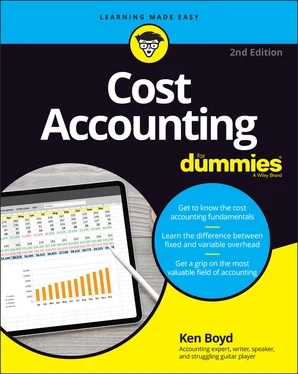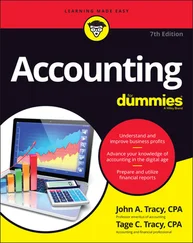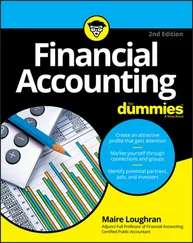Kenneth W. Boyd - Cost Accounting For Dummies
Здесь есть возможность читать онлайн «Kenneth W. Boyd - Cost Accounting For Dummies» — ознакомительный отрывок электронной книги совершенно бесплатно, а после прочтения отрывка купить полную версию. В некоторых случаях можно слушать аудио, скачать через торрент в формате fb2 и присутствует краткое содержание. Жанр: unrecognised, на английском языке. Описание произведения, (предисловие) а так же отзывы посетителей доступны на портале библиотеки ЛибКат.
- Название:Cost Accounting For Dummies
- Автор:
- Жанр:
- Год:неизвестен
- ISBN:нет данных
- Рейтинг книги:4 / 5. Голосов: 1
-
Избранное:Добавить в избранное
- Отзывы:
-
Ваша оценка:
- 80
- 1
- 2
- 3
- 4
- 5
Cost Accounting For Dummies: краткое содержание, описание и аннотация
Предлагаем к чтению аннотацию, описание, краткое содержание или предисловие (зависит от того, что написал сам автор книги «Cost Accounting For Dummies»). Если вы не нашли необходимую информацию о книге — напишите в комментариях, мы постараемся отыскать её.
Cost Accounting For Dummies
Cost Accounting For Dummies
Cost Accounting For Dummies — читать онлайн ознакомительный отрывок
Ниже представлен текст книги, разбитый по страницам. Система сохранения места последней прочитанной страницы, позволяет с удобством читать онлайн бесплатно книгу «Cost Accounting For Dummies», без необходимости каждый раз заново искать на чём Вы остановились. Поставьте закладку, и сможете в любой момент перейти на страницу, на которой закончили чтение.
Интервал:
Закладка:
Your external users want financial statements on a periodic basis. Companies typically issue financial statements on a bi-annual, or annual basis. External users want to know how you’re doing — for a variety of reasons.
Considering your shareholders
If you own a business, shareholders own shares of your company in the form of common stock. That also means that shareholders own equity in your business. You may pay them a share of company earnings as a dividend, or retain the earnings for use or investment in your business .
Shareholders are interested in seeing the value of the business increase. As your sales and earnings grow, your company is seen as more valuable. A shareholder reviews your financial statements to see if sales and earnings are increasing. If they are, your shareholder is happy — they may even buy more of your common stock.
As sales and earnings grow, other investors may be willing to pay a higher price for your common stock. An existing shareholder might then sell their investment in common stock for a gain.
Mulling over creditors
Creditors are lenders. They lend your company money so you can purchase assets, which help your business operate. Assets are defined as items you use to make money in your business, like machinery and equipment. You sign a loan agreement with a lender, and that agreement states the interest rate for the loan and when the loan payments are due. You pay interest on the loan and also repay the original amount borrowed — the principal amount.
Instead of a bank loan, you can issue debt directly to the public by selling bonds. The bond certificate states the terms of the bond. That document lists the interest rate and the maturity date. The bond investor is repaid on the maturity date.
A creditor is interested in your ability to pay the interest and repay the loan. Like a shareholder, a creditor wants to see a company that generates earnings and an increasing level of sales. If you create earnings, you eventually collect more cash than you spend. That additional cash pays the principal and interest on the loan.
Addressing concerns of regulators
Nearly every business falls under some sort of regulation. Regulators protect the public by enforcing laws and regulations. Part of that process involves reviewing your financial statements.
In addition to the “standard” set of financial reports (covered later in the book), regulators may require extra information from you. This specialized reporting is required to address a specific regulation or law. For example, if you’re a food manufacturer, the Food and Drug Administration (FDA) requires you to disclose food ingredients on a food label. That’s a form of specialized reporting for a regulator.
Using management accounting
Management accounting is the process of creating accurate and timely reports for managers. Managers use the reports to make decisions. There are many theories and accepted practices in management accounting for developing reports. Ultimately, management accounting uses the “whatever works” method to create reports. Any report that provides the best possible information to solve a problem is a good one.
Management accounting is an internal reporting process. The information you create isn’t shared with the outside world. So you can put together any type of report that’s helpful to you.
 As an accountant, you may be in a situation in which management asks you to create lots of reports but doesn’t use them all. Ask management how a report you’re asked to create will be used. The manager might conclude that the report really isn’t necessary — which saves you time and energy.
As an accountant, you may be in a situation in which management asks you to create lots of reports but doesn’t use them all. Ask management how a report you’re asked to create will be used. The manager might conclude that the report really isn’t necessary — which saves you time and energy.
Financial accounting looks backward. You report on past events. Management accounting is forward-looking. It’s prospective. You’re using the reports to make decisions about the future. For example, a decision whether to manufacture a product component or buy it from someone else is a typical management decision based on management accounting.
 Every manager has a preferred set of management reports, the ones they consider the most useful. I had a conversation with the retired chief financial officer (CFO) of a worldwide defense contractor. Engineers, including all senior management, dominated the company. The former CFO told me that he was successful because he figured out which financial management reports the engineers wanted. In fact, that set of reports was standardized and used in every senior management meeting.
Every manager has a preferred set of management reports, the ones they consider the most useful. I had a conversation with the retired chief financial officer (CFO) of a worldwide defense contractor. Engineers, including all senior management, dominated the company. The former CFO told me that he was successful because he figured out which financial management reports the engineers wanted. In fact, that set of reports was standardized and used in every senior management meeting.
Fitting in cost accounting
Cost accounting is closer to management accounting than financial accounting. Cost accountants gather information to make decisions about the future. Also, cost reports are considered to be internal reports. Both of those traits apply to management accounting.
You see overlap between cost and management accounting. A good example is special orders. A special order is an order you take on when you have excess production capacity. A customer approaches you about producing an “extra” order — an order you weren’t expecting. You need to decide what price you will accept for the special order.
Management accounting instructs you to consider only the cost and revenues that change, based on your decision, called differential costs and revenues. That makes sense, because the method is forward-looking. Old, unchanging stuff generally doesn’t count.
Your price for the special order depends on the costs. Reports you generate about costs help you make the decision to accept or reject the special order. If you’re producing cost reporting, that sounds like cost accounting to me. So you see how cost and management accounting can overlap. There’s more on special orders later.
Cost accounting sometimes uses historical information to start the analytical process. For example, when you plan your costs for next year, you take a look at spending in past years. Spending in prior year provides a starting point for planning costs — a baseline. The baseline is adjusted for all the foreseeable changes that might occur in the New Year. That helps you decide whether your budgeted costs should be higher or lower.
Using Cost Accounting to Your Advantage
Cost accounting runs through your entire business process. To begin, you decide whether the cost of obtaining the information is worth the benefit you receive from it. If you decide that it is, you use cost accounting to analyze your costs, make decisions, and look for cost reductions in your business.
Starting with cost-benefit analysis
The cost of obtaining information should be lower than the benefit you receive from your analysis. The cost includes labor hours and technology costs. For example, you need someone to search for the information. You also may need to create new cost reports in using your technology. The benefit of performing the analysis is the cost savings you’re able to implement.
Say you manufacture dining room tables; you make five different models of tables. At one point in production, your staff sands the wooden tabletops by hand.
Until now, you haven’t calculated the time required to sand each type of table. You take the total labor costs for sanding and trace them to each table, regardless of the model. Maybe you should do a cost analysis and assign the sanding cost to each table model.
Читать дальшеИнтервал:
Закладка:
Похожие книги на «Cost Accounting For Dummies»
Представляем Вашему вниманию похожие книги на «Cost Accounting For Dummies» списком для выбора. Мы отобрали схожую по названию и смыслу литературу в надежде предоставить читателям больше вариантов отыскать новые, интересные, ещё непрочитанные произведения.
Обсуждение, отзывы о книге «Cost Accounting For Dummies» и просто собственные мнения читателей. Оставьте ваши комментарии, напишите, что Вы думаете о произведении, его смысле или главных героях. Укажите что конкретно понравилось, а что нет, и почему Вы так считаете.












